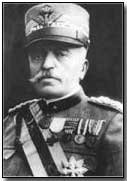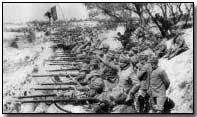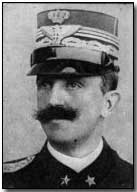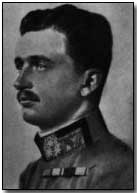Memoirs & Diaries - The Battle of Caporetto
 Now followed, as if from a
blue sky, that tremendous cataclysm which almost ruined Italy and bade fair
to ruin the cause of her Allies, but ended in giving to her a new national
purpose and discipline, and to the Allies a closer unity.
Now followed, as if from a
blue sky, that tremendous cataclysm which almost ruined Italy and bade fair
to ruin the cause of her Allies, but ended in giving to her a new national
purpose and discipline, and to the Allies a closer unity.
History, obedient to the popular instinct for the concentrated and the picturesque, has already decided to call the whole sequence of great events by the name of a little Alpine market-town.
All the meanings now implied by the word "Caporetto"- the immense and complicated causes and effects of the disaster of which the military sweep over two provinces and the rally on the Piave were merely the symbols; the mentality and character of a race; the merits and defects of its political and educational system; the relations of the different classes and parties to the war; the enemy propaganda; the grievances of the soldiers at the front; the world-strategy of Ludendorff and the new German tactics; the actions of Cadorna and his subordinates; Rapallo and the coming of the Allies; and all the shifting fortunes of that wide-flung winter battlefield - these things will fill volumes, shelves, and libraries in the generations to come.
And, regardless of all this massive learning and controversy, the people's own tradition, told by the peasant at his fireside, will burn itself, deep as the shame and pride of Cannae and its sequel, into the memory of the oldest civilized race in the world. Here I have only a few remarks to offer and a few scenes to describe, which have no claim to notice beyond the fact that I had lived long with the army most involved in the disaster, and that I was one of the straws whirled on that vast ebb-tide.
In order to understand the nature of the phenomenon, before inquiring into its causes, it is necessary to realize that there were three distinct categories of conduct among the Italian troops. To confuse any one of these three categories with either of the other two is to misunderstand the whole affair.
 First, there were a few
regiments who, in accordance with a previously-formed intention, abandoned
their duty, and surrendered on purpose. This was "Caporetto" in the
narrower and more strictly accurate sense, for it was only in that
geographical zone that such betrayal occurred; but unfortunately Caporetto
was the key to the whole strategic position.
First, there were a few
regiments who, in accordance with a previously-formed intention, abandoned
their duty, and surrendered on purpose. This was "Caporetto" in the
narrower and more strictly accurate sense, for it was only in that
geographical zone that such betrayal occurred; but unfortunately Caporetto
was the key to the whole strategic position.
The phenomenon of voluntary surrender had been so common in the Austrian army throughout the war, beginning with the early battles round Lemberg, that an elaborate system based on trustworthy machine gunners had been devised to meet it; but it was so exceptional in the Italian army that it took the authorities who might have prevented it by surprise, and struck them with something akin to panic.
When, consequently, a general retreat had been ordered, the second category of conduct was observable in a much larger number of men. The army of Bainsizza, San Gabriele, and Gorizia, who had no thought of giving way when the enemy offensive began in the last week of October, successfully resisted the attacks made on their positions, until the order came from Cadorna to retreat beyond the Tagliamento.
They carried out irreproachably the difficult retirement across the Isonzo gorge and out of the hills; but as they proceeded over the plain, hustled by the victorious enemy pouring down on their flank from Cividale, they were gradually infected by the sense that all was lost. Mainly between Udine and the Tagliamento, they gave way at length to the war-weariness which had so long been at strife with their valour and patriotism, flung away their rifles wholesale, and passed round the word, "Andiasno a casa" ("We're going home").
The last scenes of the Second Army were a sad falling from what the same men had shown themselves two months before.
The third and largest category of all consisted of the troops who did their duty throughout. Most of, though not quite all, the Third Army from the Carso, and the Fifth, First, and Fourth Armies on the Cadore and Trentino fronts, saved Italy by holding fast where required, and retreating in order where necessary, so that the shorter line was successfully established in the early days of November.
Many heroic feats of individual companies, regiments, and divisions illumined the worst hours of the Retreat. And some of the finest of these were performed by units of the Second Army itself, both in the mountain region of Matajur above Caporetto, and in the plain of Udine.
 I may be regarded as
partial, but I believe that the Second Army, though it can scarcely complain
if it has been made to bear the sins of the nation, was not really a worse
army than any other, except for the untried and undesirable elements whom
the authorities had carelessly thrust into Caporetto that autumn.
I may be regarded as
partial, but I believe that the Second Army, though it can scarcely complain
if it has been made to bear the sins of the nation, was not really a worse
army than any other, except for the untried and undesirable elements whom
the authorities had carelessly thrust into Caporetto that autumn.
The men at Plava and Gorizia had up till then performed the most brilliant and sustained feats of arms done by any part of the Italian forces, and if at last they gave way worse than the others, that was only in proportion to their geographical propinquity to the breakthrough on their flank and rear.
Elements in the Third Army suffered the same disintegration for the same reason. The half-million men of whom the Second Army was composed must not be condemned in a mass, nor their previous achievements forgotten. None the less the now established tradition that the Duke of Aosta's Third Army saved the situation by its superior discipline in the retreat from the Carso and by turning to bay behind the Piave, represents an essential truth.
Such in the main were the phenomena; but their causes are a subject far more diffused and obscure, on which I can only aspire to throw some feeble lights from my personal experience and observation.
Of the positive treachery at Caporetto itself I can say little, because I was not there, and the cars of our unit had been withdrawn from that zone before the regiments in fault were sent up. It is common knowledge that the ranks of these regiments were filled up with several thousands of the munition workers who had taken part in the recent Turin revolt. To concentrate these men at Caporetto as a punishment was not a very fortunate inspiration.
I know from what I have been told by those who were in Caporetto in the last weeks before the disaster, that the soldiers made no secret of their intentions, and that many of their officers lived in fear of their own men, locking themselves up carefully at night. Indeed, certain of these troops refused to accept the usual gifts distributed by patriotic agencies among the men at the front, grounding their refusal on the fact that they regarded themselves as no longer in service.
 This refusal, as I know,
gravely alarmed certain persons in Venice, and was, therefore, probably
known in other quarters up and down Italy. But since there had been so
little treachery in the Italian army heretofore, and since Caporetto was
regarded as a quiet part of the line, the responsible authorities left
matters alone.
This refusal, as I know,
gravely alarmed certain persons in Venice, and was, therefore, probably
known in other quarters up and down Italy. But since there had been so
little treachery in the Italian army heretofore, and since Caporetto was
regarded as a quiet part of the line, the responsible authorities left
matters alone.
Possibly the too great isolation in which the Comando Supremo was said to live under General Cadorna's regime is partly responsible for the failure to scent the smoke before the fire. If so, that General, to whom Italy and the Allies owe so much, has dearly paid for the defects of his qualities.
With regard to the bulk of the Second Army, I can speak at first hand of the men who had hitherto borne the burden and heat of the day, but who, after the retreat had been ordered, were gradually infected by hills from Caporetto to Cividale, and if once the Austro-Germans could debouch on Cividale they had turned the flank and rear of all the armies on the Isonzo front.
It was true that Monte Nero could not be taken by assault, but if low-lying Caporetto was captured behind it, the Alpini on the great mountain could be isolated and masked while the race to the plain went on. Caporetto could be attacked from Plezzo and from Tolmino, down and up the course of the Isonzo. The Monte Nero positions were really too high up to protect the town at their feet.
These operations were rendered the easier by the dangerously sharp angle here formed by the Italian line. This angle was threatened by the Austrians' bridgehead at Santa Lucia, which their successful defence of Lorn in the last days of August had still left in their hands. And now they were in correspondence with the disaffected regiments sent up to guard these vital but little regarded positions.
Everything pointed to this as the place for the attack by von Below's six German divisions, employing Ludendorff's new tactics of "infiltration," with which successful experiments had already been made on the Russian front in September.
On these lines the stroke was played on October 24, 1917, with complete success. The pace and course of the Austro-German advance after Cadorna had given the general order to retreat can be quickly traced.
 Not only did the
debouchment into the plain at Cividale compel the rapid retirement of the
Gorizia and Carso armies, but as the right wing of the victorious advance
swept along the northern edge of the plain, closing up one valley's mouth
after another, they dictated an ever-hastier evacuation of the Carnic,
Cadore, and Feltre Alps by the Fourth Italian Army.
Not only did the
debouchment into the plain at Cividale compel the rapid retirement of the
Gorizia and Carso armies, but as the right wing of the victorious advance
swept along the northern edge of the plain, closing up one valley's mouth
after another, they dictated an ever-hastier evacuation of the Carnic,
Cadore, and Feltre Alps by the Fourth Italian Army.
Alpini officers have described to me their misery at having to abandon, through no fault of their own or of the men under them, not only their guns but all the marvellous positions in the highest Alps which it had been for two years past their pride to guard and perfect for Italy.
Many of the retreating columns fought magnificent rearguard actions, attacking and thrusting back the enemy from points which imperilled the retreat of other units in the vast and difficult area of evacuation.
Source: Source Records of the Great War, Vol. V, ed. Charles F. Horne, National Alumni 1923
Photographs courtesy of Photos of the Great War website.
French tanks were used for the first time in battle on 17 April 1917, when the 'Char Schneider' (as they were known) was used during the Second Battle of the Aisne.
- Did you know?
